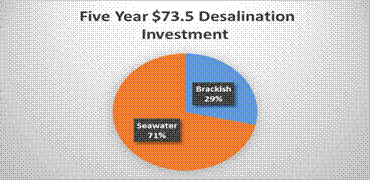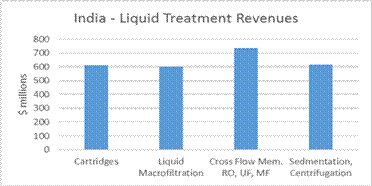2017 High Performance Cartridge Sales Will Be $4.6 Billion
Total sales of cartridges for liquid filtration in 2017 will be $17 billion.
High performance cartridge sales will be $4.6 billion, whereas sales of general
purpose cartridges will be $12.4 billion. All of the $5 billion of
cartridge sales for residential use will be general purpose. All of the
$3.5 billion of commercial cartridges will be general purpose. By
contrast, high performance cartridge sales in the pharmaceutical industry will
exceed $1.6 billion. High performance cartridge sales for healthcare will
exceed $1 billion. These are the latest forecasts in
N024 Cartridge Filters: World Market.
|
Industry |
High
Performance
Percentage |
|
Chemical |
50 |
|
Commercial – Point-of-Entry |
0 |
|
Commercial – Point-of-Use |
0 |
|
Electronics |
75 |
|
Food |
60 |
|
Healthcare |
60 |
|
Metals |
50 |
|
Oil & Gas |
60 |
|
Other Industries |
40 |
|
Pharmaceutical |
70 |
|
Power |
50 |
|
Residential – Point-of-Entry |
0 |
|
Residential – Point-of-Use |
0 |
|
Wastewater |
30 |
|
Water |
30 |
There is a big difference in price and sales approach between high performance
and general purpose cartridges.
McIlvaine is using its own definition of high performance to include:
·
Unique service
·
Severe service
·
Critical service
Unique service is defined as a cartridge which is custom engineered for an
application. The media, size and/or materials for the vessel are varied to
meet a customer’s need. The extent to which a cartridge is unique can be
measured by how much more a customer is willing to pay for the custom design
rather than be content with an off the shelf alternative. A paint
manufacturer may want a cartridge that is not too efficient on small particles
but does remove the large ones. The reason is that the small particles are
the ones providing the color. So, while with standard cartridges the higher the
efficiency the better, this will not be acceptable in paint filtration.
Severe service is defined as an application where particle adhesion, particle
size, corrosion, erosion, pressure, or temperature is a concern. Purchasers are
willing to pay more for better severe service cartridges because the alternative
is high replacement rates, high maintenance cost and potential disruption to
processes. The refining, chemical and power industries have many severe service
applications.
Critical service is defined by the importance of the cartridge performance.
If safety, health, or quality of the goods manufactured are impacted by
cartridge performance, then it would be critical service. An example would
be cartridges in the semiconductor industry which must remove any particles
which would otherwise cause damage to a computer chip. By contrast, the carbon
cartridge in a refrigerator may deteriorate to where taste is impacted but
failure would not be critical. The food, pharmaceutical and chemical industries
utilize cartridges for food processing and, therefore, performance of the
cartridge is critical.
Identification of the high performance cartridge segment is important to
cartridge suppliers. High performance cartridges offer the opportunity for
higher profit margins. They are also sold based on determining the lowest
total cost of ownership. Therefore, the route to market is different than
for general purpose cartridges.
For more information on N024 Cartridge Filters: World Market, click on:
http://home.mcilvainecompany.com/index.php/markets/2-uncategorised/117-n024
Desalination System Investment to Exceed $14 Billon/yr. over the Next Five Years
In the next five years, suppliers of thermal and membrane desalination systems
will sell systems valued at $73.5 billion of which $21 billion will be spent on
brackish water systems and $52.5 billion for seawater systems. This is the
conclusion reached by the McIlvaine Company by aggregating forecasts appearing
in its cross-flow membrane, pump, valve and filtration reports.
![]()
The brackish water forecast is less precise than the seawater forecast due to
the definition of the term “brackish.” This can include total dissolved
solids content as low as 500 ppm to as high as 2000 ppm.
The potential for desalination is very high. In 2015 desalination equaled
only 2.3 percent of water delivered by municipalities. This percentage
will climb to 3 percent in 2020. However, since desalination is utilized
by industry and commerce, the desalination capacity should be compared to all
freshwater withdrawal. Power plants withdraw ten times more water than
municipal drinking water plants. Power plants desalinate only a minuscule
fraction of their total withdrawal. So the growth potential in power and other
industries is very large. China has issued regulations requiring power
plants with seawater access to desalinate rather than extract fresh water.
A significant portion of the seawater desalination investment will be for
thermal plants but membrane technology will continue to gain market share.
There are promising new technologies such as electrochemical desalination and
forward osmosis which promise higher energy efficiency, greater liquid recovery
and lower costs of ownership.
The future of desalination depends on the sustainability criteria which will be
used to justify the investment. The fact that the harm is global but the
value local creates different evaluations. The cost of CO2
according to some EPA analyses is $50 ton. However, CO2 emitted in
San Diego does not harm local residents any more than it does citizens of the
EU. On the other hand, desalinated water in San Diego benefits local
residents exclusively. The residents in the Colorado River Delta will be
more enthusiastic about a San Diego desalination investment than any other
group. McIlvaine has developed
Sustainability Universal Rating System
to rationalize these different perspectives.
A free webinar to discuss the market will be held on Thursday, July 14, 2016.
Click here to Register for the Webinars
For more information on a customized desalination market study contact Bob
McIlvaine at 847-784-0012 ext. 112
rmcilvaine@mcilvainecompany.com
For more information on the various relevant multi client market reports click
on:
http://home.mcilvainecompany.com/index.php/markets
Gas Turbine Owners Will Spend $1.3 Billion for Ultrapure Water Systems at New
Gas Turbine Combined Cycle Power Plants
Ultrapure water (UPW) systems are critical to the steam cycle in gas turbine
combined cycle (GTCC) plants. In 2017 more than $1.3 billion will be spent
on UPW systems for new GTCC generators. NAFTA will lead the way with 35
percent of the purchases. These forecasts were reached through McIlvaine
research for N029
Ultrapure Water: World Market
and
59EI Gas
Turbine and Combined Cycle Supplier Program.

UPW components for GTCC plants are challenged by the rapid cycling which is
required. Wind and solar are playing an increasing role in power
generation but their operations are not constant. As a result, the GTCC
plants are operated to balance the fluctuating contribution from the other
sources. Flow accelerated corrosion and other problems are being addressed.
Operators are being assisted in dealing with these problems in another
McIlvaine service 59D
Gas Turbine and Combined Cycle Decisions.
For more information on the reports and databases contact Bob McIlvaine at
847-784-0012 ext. 112
rmcilvaine@mcilvainecompany.com
Granular Media Filter Sales to Exceed $2.4 Billion in 2021
Granular media filters will account for 29 percent of the world liquid
macrofiltration market in 2021. This is the latest forecast in
N006 Liquid Filtration and Media World Markets
published by the McIlvaine Company.

Granular media filter functions can be divided into particulate and dissolved
segments. The market for particulate removal in drinking water plants will
expand slower than the total market due to market share loss to cross-flow
membranes. On the other hand, the market for removing dissolved contaminants is
booming.
Perfluorinated compounds, or PFCs, are manmade, fully fluorinated compounds that
are not naturally found in the environment and are used in a range of products
such as fire-fighting foams and coating additives. PFOS and PFOA are the most
commonly produced PFCs.
PFOA and PFOS are persistent and itinerant in the atmosphere and aqueous
environments due to their high chemical stability and low volatility. In their
anionic form, PFCs are water soluble and can easily travel from soil to
groundwater, carrying the contaminants long distances. Toxicological reports
indicate potential developmental, reproductive and systemic effects after oral
exposure, as PFCs accumulate and absorb in the serum, kidney and liver. Because
PFCs are resistant to direct oxidation, photolytic degradation, biodegradation
and air stripping/vapor extraction, their removal is very difficult.
AdEdge, Cabot, Calgon Carbon, Carbon Activated
Corp. , CEI Carbon, Evoqua, Jacobi Carbon, Ovivo, Oxbow and VAF filters are
offering PFC removal solutions. Calgon Carbon demonstrated that granular
activated carbon (GAC) is an effective way to remove PFCs from sources of
drinking water. GAC is successful in removal of harmful compounds in
groundwater, including PFOA as well as perfluorobutanoic acid (PFBA),
perfluoropentanoic acid (PFOA), perfluorohexanoic acid (PFHxA) and
perfluorodecanoic acid (PFDA). The spent activated carbon, containing adsorbed
PFCs, can be thermally reactivated, thereby destroying the contaminants and
allowing the activated carbon to be recycled and reused in groundwater treatment
applications. Lab testing and field trials have led to activated carbon systems
being successfully employed to treat groundwater for PFC removal throughout
North America.
For more information on Liquid Filtration and Media: World Market
click on:
http://www.mcilvainecompany.com/brochures/water.html#n006
Gas Turbine Owners Will Spend $300 Million for Pumps at New Gas Turbine Combined
Cycle Power Plants
Pumps are critical to the steam cycle in gas turbine combined cycle
(GTCC) plants. In 2017 more than $300 million will be spent on pumps for
new GTCC generators. NAFTA will lead the way with 35 percent of the
purchases. These forecasts were reached through McIlvaine research for
N019
Pumps World Market and
59EI Gas
Turbine and Combined Cycle Supplier Program

Boiler feedwater pumps for GTCC plants are challenged by the rapid cycling which
is required. Wind and solar are playing an increasing role in power
generation but their operations are not constant. As a result, the GTCC
plants are operated to balance the fluctuating contribution from other sources.
Flow accelerated corrosion and other problems are being addressed.
Operators are being assisted in dealing with these problems in another
McIlvaine service 59D
Gas Turbine and Combined Cycle Decisions.
For more information on the reports and databases contact Bob McIlvaine at
847-784-0012 ext. 112
rmcilvaine@mcilvainecompany.com
HOT
TOPIC HOUR (HTH) SCHEDULE
|
DATE |
HOT TOPIC HOUR
AND DECISION
GUIDE SCHEDULE
The opportunity
to interact on
important issues |
|
July 14, 2016 |
Desalination
Thermal vs. Membrane; energy
recovery, pump, valve,
compressor and chemicals
options; power/desalination
combinations. |
|
July 14, 2016 |
NOx Control for PacifiCorp:
Overview and Summary of Low NOx
Options
Discussion of options for
PacifiCorp to comply with new
NOx removal requirements for
four 350 MW coal fired
generators operating in Utah.
The first webinar will consider
the range of both in-furnace and
back end options. |
|
July 19, 2016 |
NOx Control for PacifiCorp:
Combustion Modifications and
Neural Networks
Discussion of options for
PacifiCorp to comply with new
NOx removal requirements for
four 350 MW coal fired
generators operating in Utah.
This second webinar will
consider the range of both
in-furnace options to reduce NOx
to between 0.15- 0.22
lbs./MMBtu. |
|
August 2, 2016 |
NOx Control for PacifiCorp: Back
end NOx Control
Discussion of options for
PacifiCorp to comply with new
NOx removal requirements for
four 350 MW coal fired
generators operating in Utah.
This third webinar will consider
the range of options such as
peroxide, ozone, and catalysis
to reduce emissions to 0.06
lbs./MMBtu. |
|
August 25, 2016
Markets |
Oil, Gas, Refining
-
Supply and demand; impact on
flow control and treatment
products; regional impacts
e.g. subsea in North Atlantic
vs. shale in the US vs. Oil
Sands in Canada. |
|
TBA
Markets |
Food
- Analysis
of 12 separate
applications within food and
beverage with analysis of valve,
pump, compressor, filter,
analyzer and chemical options;
impact of new technologies such
as forward osmosis. |
|
TBA
Markets |
Municipal Wastewater
-
Quality of pumps, valves,
filters, and analyzers in
Chinese and Asian plants; new
pollutant challenges; water
purification for reuse. |
|
TBA
Markets |
Mobile Emissions
-Reduction
in CO, VOCs, and particulate in
fuels, oils, and air used in on
and off road vehicles; impact
of RDE and failure of NOx
traps and the crisis in Europe
created by the focus on clean
diesel. |
Click here to Register for the Webinars
Details on Webinars
McIlvaine conducts periodic webinars which are in a discussion format and are
free of charge to all participants. The displayed material and recordings are
free to purchasers of the products and services and by subscription to others.
Format: 50-90-minute recorded discussion using McIlvaine display material.
The session will be free of charge to all participants but registration is
required.
Approach: There are two types of webinars. One is focused on Markets and
directed to suppliers. The other is focused on aiding purchasers make the best
Decisions relative to purchases of flow control and treatment equipment and
services.
Markets HTH
General overviews of the market including size and major variables will be
discussed with heavy emphasis on technology and regulatory drivers. The
presentation will be based on the latest information appearing in McIlvaine
multi-client reports. Questions and views from both subscribers and
non-subscribers are encouraged.
Decisions HTH
McIlvaine has been publishing information systems on pollution control since
1974. Each subject is organized by the pollutant control technology e.g. fabric
filter, scrubber etc. There are search capabilities to retrieve information on
any application. The newest addition has been slide deck systems displaying the
issues and options relative to specific applications. Coal-fired power, cement,
steel, and waste combustion decision slide decks are continually updated.
The continually updated slide decks are displayed on the applicable Decision
System. It is recommended that participants view the slide deck in advance
of the session and be prepared with questions and views.
Value to purchasers and specifiers: Your questions and interests will be
prioritized in the discussion. You will get a monthly newsletter and have
continuing access to the system and multiple ways to interface in the future
along with a networking directory of suppliers.
Value to Suppliers: You have the opportunity to provide data to be
considered at no charge. If you are also a subscriber you will see the summaries
in advance and be able to shed light on issues and options not properly covered
in the slide deck. If you are a subscriber you will receive the monthly
newsletter and continuing yearly access to the system including networking
directories.
44I Power
Plant Air Quality Decisions
includes 1ABC, 3ABC, 4ABC, 9ABC decision services but not 2ABC. So those with
multiple technologies and at least partial focus on power will find this
combination most cost effective.
|
Applicable Services for Hot
Topic Hours** |
|||||||
|
Pollutant |
Industry |
Fabric Filter
(1ABC) |
Scrubber
(2ABC) |
Precipitator
(4ABC) |
FGD & DeNOx
(3ABC) |
Air Pollution
(9ABC) |
Gas |
|
FGD and Acid Gas |
Coal |
|
|
|
X |
X |
|
|
Sewage |
|
X |
|
|
X |
|
|
|
WTE |
|
X |
|
|
X |
|
|
|
Cement |
|
X |
|
|
X |
|
|
|
Steel |
|
X |
|
|
X |
|
|
|
*Included in custom system |
|
Sponsored Webinars
allow suppliers to take
advantage of all the valuable
information on their power point
presentations. Click
here for details |
Free Sponsored Webinars
·
Albemarle
- Cement MACT
·
Aquatech
·
NVISTA
·
Midwesco - Bagfilter Performance
Analyzer
·
Pavilion
·
Sick Maihak
- Cement MACT
·
Tekran Instruments
- Cement MACT |
----------
You can register for our free McIlvaine Newsletters at:
http://home.mcilvainecompany.com/index.php?option=com_rsform&formId=5
Bob McIlvaine
President
847-784-0012 ext 112
rmcilvaine@mcilvainecompany.com
www.mcilvainecompany.com